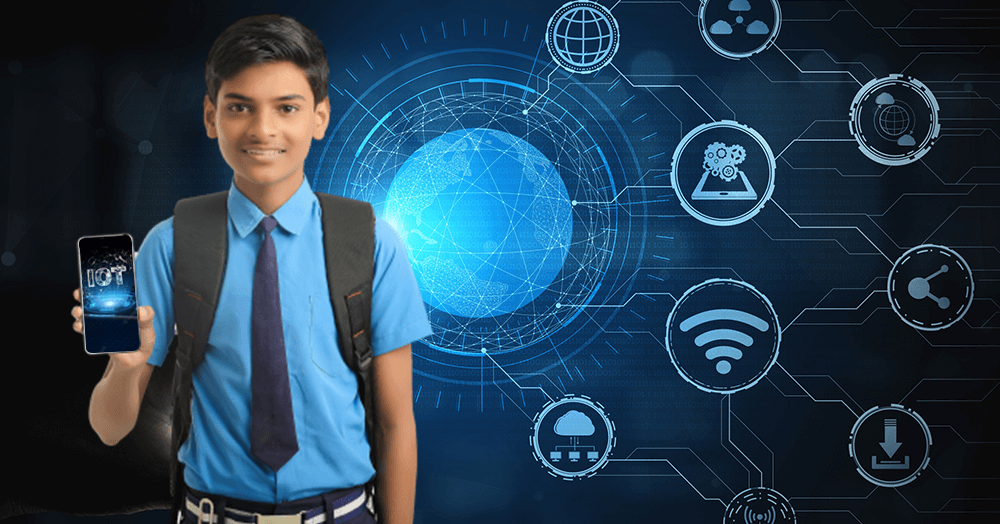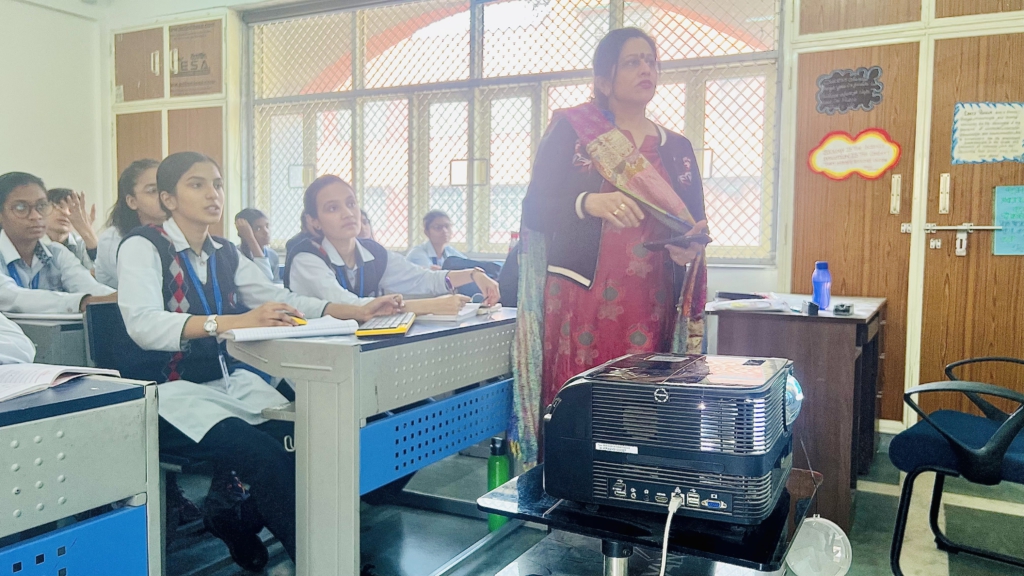Blogs
Smart Classroom: The Future of Learning with IoT Integration

New-age schools and colleges are offering Smart Classroom to their students to stand out from the clutter of educational institutions. These technology-enabled classrooms offer teaching and learning courses by integrating learning technology, such as computers, specialized software, audience response technology, assistive listening devices, networking, and audio/visual capabilities. The fast adoption of EdTech advancements is going to revolutionize the way students learn and upskill themselves.
IoT (Internet Of Things) systems are spearheading these incredible developments. IoT has the power to assist you in making correct decisions based on data it collates to streamline every aspect of human activity and make life simple. Making this possible is a network of sensors and actuators in IoT systems that erase the division between the physical and digital worlds.
Smart Classroom: IoT Is All Around Us
Internet of things (IoT) connects physical objects with the Internet. It collects data from smart devices and shares the information with you to enable smart decision-making. The IoT concept utilises different technologies like sensors, machine learning, artificial intelligence, real-time analysis, and embedded systems. IoT applications are reaching smart cities, cars, devices, entertainment systems, homes, and connected healthcare. These devices improve productivity and quality of life.
The Importance of Modernizing the Education Sector
Utilizing state-of-the-art and modern teaching methods can bolster the economic progress of a country. Parents too are optimistic about the role of smart classroom technology such as computers and educational software, in their child’s life. With electronic devices are becoming common in schools, teaching methods are becoming more interactive and personalised.
How Can IoT Systems Be Implemented in a Classroom?
IoT has begun to reform the educational system in a big way. The inter-connectivity that it enables is linking previously disconnected offline objects like school boards, projectors, and devices like desktops, mobiles among others.
An IoT enabled classroom can be equipped with the following IoT systems:
- - Interactive whiteboards
- - Automated attendance tracking systems
- - Student ID cards
- - Temperature and environmental sensors
- - Smart, efficient lighting and predictive maintenance for infrastructure
- - Smart HVAC systems
- - Wireless door locks and lockdown protocols
- - Security systems
With the speed at which mobile devices, mobile apps, and IoT are reaching even the remotest corner of India, more and more students across India are getting familiar with EdTech.
Smart education is now becoming more and more acceptable in the education universe. With the constant introduction of new technologies into institutional learning, smart classrooms enable users to enrich their academic knowledge, develop creative skills, and expect higher learning outcomes.
It’s time for EdTech companies to look at the increasing demands to design a scalable and flexible IoT architecture for smart education (IoTASE).

Key SMART Classroom Terms
Learning Environment: A virtual learning environment (VLS) empowers learners to pursue their academic knowledge. It also assists teachers to follow their passion for teaching through a robust online professional development system. VLS provides live classroom instructions, tests, exercises, learning materials, activities, interactions, and assessments.
Device: IoT devices include sensors, actuators, tags, and more. They support advanced functions like task automation and remote control of devices. IoT devices collate information and relay it to the other connected devices or even the users.
Mobile Learning: Mobile learning refers to education delivered on mobile devices using personal mobile devices, such as smartphones, tablets, and laptops. These mobile devices display content easily to ensure that learners can learn from them in the comforts of their home, or on the go - anywhere and anytime.
MOOCs: Massive Open Online Courses (MOOC) is a free Web-based distance learning program. IT allows learners from across the globe to come together and learn. It uses the term massive because in an instant hundred and thousands of learners could log in to learn a college or university course or just any other course.
SMART Classrooms: A SMART classroom is an EdTech-upgraded classroom that enhances the teaching and learning process for both the teachers and the students by integrating learning technologies such as computers, specialized software, audience response technology, assistive listening devices, networking, and audio/visual capabilities.
IoT Architecture: An IoT architecture is the system that harnesses all the resources, hardware, and software, however, varied they may be, into a single framework to form an integrated, reliable, and cost-effective solution.
Learning Platform: The learning platform integrates academic content that provides the teachers, learners, parents, and others involved in education with information, tools, and resources. They are easy to browse and learn from. Containing a curated list of online courses sorted subject-wise, both academic and creative, they ensure there is something to learn for everyone.
RFID: RFID or Radio Frequency Identification System is a technology-based identification system that helps identify objects, animals, or people from the tags attached to them. The results derived are quick and efficient.
E-Book: A book in electronic form that is read on a computer or handheld device rather than in print, consisting of text, images, or both.
Reference Model: A reference model represents a class of domains (e.g., a reference model for production planning and control systems). It is a conceptual framework that standardizes communication between the networks.
Thing: A thing is an article with only physical existence, but no life and can be found in our everyday environment. A thing is considered to exist as a separate entity, object, quality, or concept.
Smart Learning: Smart learning environments are IoT-based learning solutions, which are seamlessly integrated into the learning environment. With the use of context-aware digital devices, Smart learning environments focus on contextual, personalized, and seamless learning to promote learners’ intelligence.
Personalized Learning: Personalized learning refers to a method of learning that is optimized for the needs of each learner. The learning objectives, instructional approaches, and instructional content are catered based on the learner’s needs. In personalized learning, the student's strengths, needs, skills, and interests are taken into consideration.
IoT Reference Architecture: The IoT reference architecture is a fundamental way to design the various elements of IoT. This is to ensure that the services are delivered over the networks and meet the needs for the future. It also defines the guidelines that can be used when planning the implementation of an IoT system.
Smart Teaching: Teachers are learning the use of new technologies and techniques to enrich their teaching. Smart teaching involves technology and various software tools to impart education. These include multi-utility projectors, whiteboards, audio-visual aids, and interactive tools like animations too.
Functional View: The functional view of a system defines the architectural elements like data movement, apparatus control, and data processing that delivers the system's functionality. These are the three main functional views of the computer. They also include the key functional elements, their responsibilities, the interfaces they expose, and the interactions between them.
Bluetooth: It is a wireless communication method that facilitates electronic devices to connect and interact with each other. It can be found in a number of gadgets like smartphones, laptops, earphones, portable wireless speakers, hearing aids, stereo receivers, cars, fitness trackers, and more. With the help of Bluetooth, PCs can connect wirelessly to keyboards and mice.
Smart Education: Smart education is redefining the way children access education in the digital age. The use of state-of-the-art classroom software and hardware, offering immersive learning methodologies, is improving the learning outcome of the students.
Function Model: In systems engineering, software engineering, and computer science, a functional model is a structured representation of the functions (activities, actions, processes, operations) within the modeled system or subject area.
Reference Architecture: When a project manager or other party wants to refer the best practices to follow, they refer to a set of documents called the Reference Architecture. It includes general architectural principles, patterns, building blocks, and standards that form a template for the specific architecture within the domain.
Near-Field Communication: It is a set of short-range wireless connectivity standards that provides data exchange opportunities among electronic devices when they are touched together, or brought within the close vicinity of each other. Near-Field Communication is applied in many modern-day electronics like smartphones, mobile payment, wearables, access control, and more.
Software Architecture: It defines how all the components of a software system are assembled and the relationship, and communication between them. It serves as a blueprint for software application and optimizes various attributes involving a series of decisions, such as security, performance, and manageability.
SMART classroom open the door to the vast world of online study materials. It also leverages the maximum potential of IoT technologies to offer convenient and personalized learning. SMART classrooms are the future of learning.




